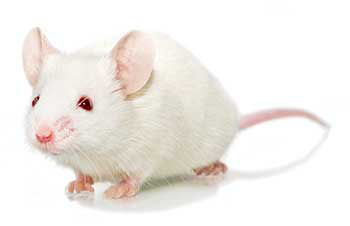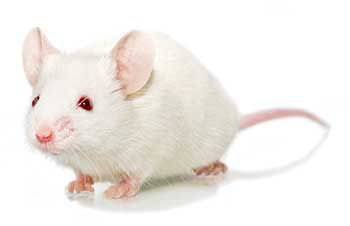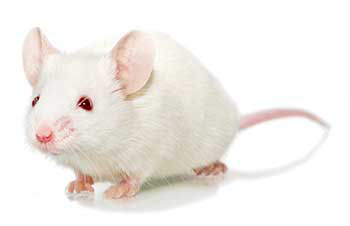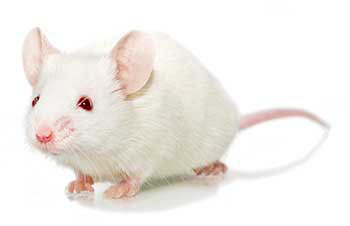Application Areas:
CIEA NOG mouse®

| Model No. | Nomenclature | Genotype |
|---|---|---|
| NOG-F | NOD.Cg-Prkdcscid Il2rgtm1Sug/JicTac | sp/sp;ko/ko |
| NOG-M | NOD.Cg-Prkdcscid Il2rgtm1Sug/JicTac | sp/sp;ko/y |
- Description
- Data
- Growth Chart
- Price & Licensing
- Health Report
- Overview
- Genetics
- Guides & Publications
- Applications & Therapeutic Areas
- Transit, Housing & Welfare
- Diet
Overview
Nomenclature: NOD.Cg-Prkdcscid Il2rgtm1Sug/JicTac
The first and most versatile severely immunodeficient mouse model
- Immunodeficient model lacking mature T, B, and NK cells
- Displays reduced complement activity
- Has dysfunctional macrophages and dendritic cells
- Displays no leakiness of T and B cells with increasing age
- Very low incidence of lymphoma (unlike NOD scid model)
- Does not develop diabetes
- Excellent model for a variety of xenograft and human cell engraftment studies
- Applications in research involving Cancer, Infectious Disease, Immunology, Regenerative Medicine, Humanization, Autoimmune Disease, Immunotherapy Vaccine, GvHD/Transplantation, Hematopoiesis, Oncology, Inflammation/Allergy, and Safety Assessment
- The Il2rg gene is sex-linked
Availability
Available now**Please note that advanced order placement is encouraged for male mice. Ordering 4 or more weeks prior to the desired shipping date is recommended when requesting males older than 3-weeks of age.
Origin
Genetics
Guides & Publications
Initial Publication: Ito M, Hiramatsu H, Kobayashi K, Suzue K, Kawahata M, Hioki K, Ueyama Y, Koyanagi Y, Sugamura K, Tsuji K, Heike T, Nakahata T. (2002) NOD/SCID/γ mouse: an excellent recipient mouse model for engraftment of human cells. Blood 100(9):3175-3182.
mouse: an excellent recipient mouse model for engraftment of human cells. Blood 100(9):3175-3182.
Applications & Therapeutic Areas
- Immunology
- Infectious Disease
- Inflammation
- Oncology & Immuno-Oncology
- Safety Assessment
- Vaccine Research
- Cell and Tissue Humanized
Transit, Housing & Welfare
Need more info? Click the live chat button or Contact Us
Packing Practices
Taconic standard practice is to recombine animals of different home cages and/or ages from a single model and sex during packing, except in specific cases where Taconic's animal welfare policy prohibits recombination due to aggression or other concerns. When an order is fulfilled with animals from more than one week of birth, this standard practice results in animals from a range of birth weeks packed together in a single TTC. When an order is fulfilled with animals from genotyped models, this standard practice results in animals from different home cages packed together in a single TTC.
Customers who wish to keep animals from different weeks of birth separated should place orders with the special instruction "Divide and label by age." Note that this special request can result in increased costs for additional Taconic Transit Cages, dividers and/or freight charges.
Taconic discourages other types of custom packing requests as they can have a negative impact on animal welfare. Learn more.
Diet
Data
Average litter size: 7
For some applications, weight may be critical. For orders where weight is critical, please place orders by weight, not by age. Taconic can accept orders by weight for this model. For orders sourced from US or Denmark a production minimum 3 gram span is accepted. All weights are weights at time of packing. Mice and rats can lose weight in transit. Orders for specific weight spans will be assessed a nominal fee. More detail on weight order policies is available.
n= 100 animal per sex Restricted Flora health standards from US colonies. Data collected 2012-2013.
High and Low represent mean +/- standard deviations.
The sample size above is not large enough to necessarily represent a normal population.
All growth curves represent animals housed in our barriers, at our standard density and fed NIH31-M diet. Variations at customer facilities will alter expected growth curves.
Growth charts are provided only as a guide, if a specific weight criteria is needed please order animals by weight.
- Licensing
- Pricing - USD
- Pricing - EUR
- Pricing - DKK
- Pricing - USD Nonprofit
- Pricing - EUR Nonprofit
- Pricing - DKK Nonprofit
- Select my Health Standard
- Get Custom Pricing Guide
CIEA NOG mouse®
Nonprofit users (excluding users at nonprofit foundations which are affiliated with a for-profit entity): For internal research purposes, the CIEA NOG mouse® Conditions of Use for nonprofit users apply. If you wish to perform sponsored research or fee-for-service contract research using the CIEA NOG mouse®, please inquire for access conditions.
For-profit users and users at foundations which are affiliated with for-profit entities: The CIEA NOG mouse® Conditions of Use for for-profit users apply.
The CIEA NOG mouse® is produced and distributed under license rights to the following patents and trademarks:
- Japanese Patent No. 3,753,321
- US Patent No. 7,145,055; 5,464,764; 5,487,992; 5,627,059; 5,631,153; 5,789,215; 6,204,061; 6,653,113; 6,689,610
EP Patent No. 1,338,198 - Japanese Trademark Reg. No. 4,823,423
- US Trademark Reg. No. 3,118,040
- EU Trademark Reg. No. 3,736,758
Pricing - USD
Opportunist Free (OF) Health Standard
NOG Female
NOG-F Genotype sp/sp;ko/ko
Available now
| Age in Weeks | Quantity 1 - 49 | Quantity 50 - 99 | Quantity 100 - 99999 |
|---|---|---|---|
| 3 to 12 | US$274.00 | US$251.00 | US$247.00 |
NOG Male
NOG-M Genotype sp/sp;ko/y
Available now
| Age in Weeks | Quantity 1 - 49 | Quantity 50 - 99 | Quantity 100 - 999 |
|---|---|---|---|
| 3 to 12 | US$206.00 | US$200.00 | US$192.00 |
Pricing - EUR
Opportunist Free (OF) Health Standard
NOG Female
NOG-F Genotype sp/sp;ko/ko
Available now
| Age in Weeks | Quantity 1 - 49 | Quantity 50 - 99 | Quantity 100 - 99999 |
|---|---|---|---|
| 3 to 10 | 250,00 € | 228,00 € | 224,00 € |
NOG Male
NOG-M Genotype sp/sp;ko/y
Available now
| Age in Weeks | Quantity 1 - 49 | Quantity 50 - 99 | Quantity 100 - 99999 |
|---|---|---|---|
| 3 to 10 | 188,00 € | 108,00 € | 175,00 € |
Pricing - DKK
Opportunist Free (OF) Health Standard
NOG Female
NOG-F Genotype sp/sp;ko/ko
Available now
| Age in Weeks | Quantity 1 - 49 | Quantity 50 - 99 | Quantity 100 - 999 |
|---|---|---|---|
| 3 to 10 | kr.1.854,00 | kr.1.694,00 | kr.1.663,00 |
NOG Male
NOG-M Genotype sp/sp;ko/y
Available now
| Age in Weeks | Quantity 1 - 49 | Quantity 50 - 99 | Quantity 100 - 999 |
|---|---|---|---|
| 3 to 10 | kr.1.395,00 | kr.798,00 | kr.1.295,00 |
Pricing - USD Nonprofit
Opportunist Free (OF) Health Standard
NOG Female
NOG-F Genotype sp/sp;ko/ko
Available now
| Age in Weeks | Quantity 1 - 49 | Quantity 50 - 99 | Quantity 100 - 99999 |
|---|---|---|---|
| 3 to 12 | US$122.00 | US$114.00 | US$110.00 |
NOG Male
NOG-M Genotype sp/sp;ko/y
Available now
| Age in Weeks | Quantity 1 - 49 | Quantity 50 - 99 | Quantity 100 - 999 |
|---|---|---|---|
| 3 to 12 | US$114.00 | US$111.00 | US$107.00 |
Pricing - EUR Nonprofit
Opportunist Free (OF) Health Standard
NOG Female
NOG-F Genotype sp/sp;ko/ko
Available now
| Age in Weeks | Quantity 1 - 49 | Quantity 50 - 99 | Quantity 100 - 99999 |
|---|---|---|---|
| 3 to 10 | 111,00 € | 103,00 € | 99,00 € |
NOG Male
NOG-M Genotype sp/sp;ko/y
Available now
| Age in Weeks | Quantity 1 - 49 | Quantity 50 - 99 | Quantity 100 - 99999 |
|---|---|---|---|
| 3 to 10 | 103,00 € | 100,00 € | 97,00 € |
Pricing - DKK Nonprofit
Opportunist Free (OF) Health Standard
NOG Female
NOG-F Genotype sp/sp;ko/ko
Available now
| Age in Weeks | Quantity 1 - 49 | Quantity 50 - 99 | Quantity 100 - 999 |
|---|---|---|---|
| 3 to 10 | kr.820,00 | kr.767,00 | kr.736,00 |
NOG Male
NOG-M Genotype sp/sp;ko/y
Available now
| Age in Weeks | Quantity 1 - 49 | Quantity 50 - 99 | Quantity 100 - 999 |
|---|---|---|---|
| 3 to 10 | kr.767,00 | kr.744,00 | kr.720,00 |
Select my Health Standard
Need help choosing the right Taconic Biosciences health standard for your research?
Use the Health Standard Selector to enter your exclusion list. The tool will tell you which health standards meet your requirements.
Get custom pricing guide
Schedule A Scientific Consultation
Connect directly with a member of our Scientific Solutions team who can help you select the most appropriate model and maximize your experimental success.
Related Models
Smart Select Program
Free Animal Model Trial: Quality & Compatibility Assurance
To help alleviate uncertainty in selecting a new model, we offer a free animal trial program that allows you to test the quality, consistency, and availability of Taconic’s rodent models. Pilot our most popular mouse or rat models in your facility at no cost to your organization with the Smart Select program.
- Evaluate a specific model strain, before making any financial investment
- Request up to 20 animals from one of the strains listed here to test for quality, consistency, and suitability for your experimental purpose
- Enjoy free ground shipping, where applicable (see table for more details)
Hear From our Scientists
“Experimental Pharmacology & Oncology (EPO) GmbH uses 1st and 2nd generation NOG mice provided by Taconic for its preclinical oncology service. These mice are included in novel concepts for the development of personalized treatment options and especially suited for humanization strategies. We are very satisfied with the quality of mice, the reliability of shipment and the high level of scientific support. Further, we very much appreciate the competent and always friendly communication.”
— Experimental Pharmacology & Oncology (EPO) GmbH
“We are very pleased to be working with Taconic NOG and hIL-15 NOG mouse models. Our customer experience is very good. We appreciate their flexibility and availability.”
— Affimed GmbH
- Section 1
- Section 2
















.jpg)

.jpg)
.jpg)
.jpg)
.jpg)





.jpg)


.jpg)
.jpg)




.jpg)




.jpg)

.jpg)









